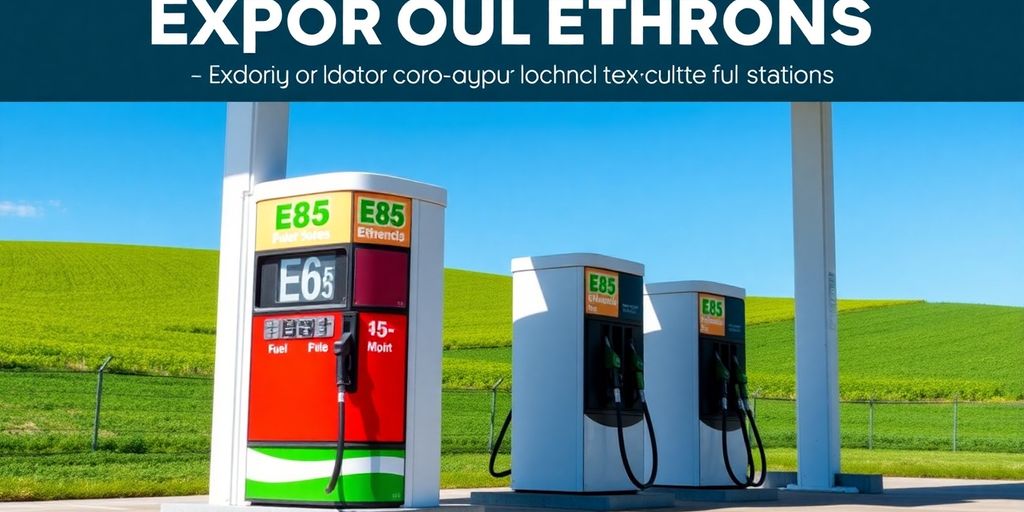If you’re curious about E85 fuel and how to find it, you’re in the right place. This guide will help you understand what E85 is, its benefits, and where you can find it. Whether you’re driving a flex-fuel vehicle or just looking to explore eco-friendly fuel options, this information will be valuable for you.
- Discover the Best Boutique Shop Near Me: A Local’s Guide to Unique Finds
- Discover Where Do Kids Eat Free Today Near Me: Your Ultimate Dining Guide
- Who Buys Jewelry Near Me? Discover Local Buyers Offering the Best Cash Deals
- Exploring Veg Non Veg Restaurants Near Me: A Culinary Adventure for Every Palate
- Who Buys Junk Mobile Homes Near Me? Discover Local Buyers Ready to Make You an Offer!
Key Takeaways
- E85 is a blend of 85% ethanol and 15% gasoline, making it a renewable fuel option.
- Using E85 can reduce greenhouse gas emissions compared to regular gasoline.
- Finding E85 stations can be done easily through apps or by checking along major highways.
- Flex-fuel vehicles are designed to run on E85, but not all cars can use it safely.
- E85 may not be available everywhere, so it’s important to know your local fuel options.
Understanding E85 Fuel and Its Benefits
What is E85 Fuel?
E85 is a type of fuel that contains 85% ethanol and 15% gasoline. It is designed for use in flex-fuel vehicles (FFVs), which can run on any mix of ethanol and gasoline. Ethanol is made from renewable resources like corn and sugarcane, making E85 a more sustainable option compared to traditional gasoline.
You are viewing: Discover Who Sells E85 Gas Near Me: Your Ultimate Guide to Finding Ethanol Fuel Stations
Benefits of Using E85 Fuel
Using E85 fuel has several advantages:
- Lower greenhouse gas emissions: E85 burns cleaner than regular gasoline, which helps reduce air pollution.
- Supports local agriculture: Since ethanol is often made from crops, using E85 can help local farmers.
- Potential cost savings: In some areas, E85 can be cheaper than regular gasoline, although this can vary.
Environmental Impact of E85
E85 has a positive impact on the environment, but there are some challenges:
- Reduced emissions: E85 can lower emissions of harmful gases like carbon monoxide and nitrogen oxides.
- Energy value: However, E85 has a 33% lower heating value compared to gasoline, which means you may need more fuel to travel the same distance.
- Land use concerns: Growing crops for ethanol can compete with food production, raising concerns about land use.
E85 is a step towards cleaner fuel options, but it’s important to consider both its benefits and challenges.
How to Locate E85 Gas Stations Near You
Using Online Tools and Apps
Finding E85 gas stations can be made easier with the help of technology. Here are some effective methods:
- E85 station locator websites can provide a list of nearby stations.
- Mobile apps designed for fuel finders can show you the closest E85 options.
- Online maps can help you visualize the locations of E85 stations in your area.
Checking Major Highways and Routes
E85 fuel is often available along major highways. Here’s how to check:
- Look for signs indicating E85 availability at gas stations.
- Plan your route to include stops at known E85 stations.
- Use travel apps that highlight fuel options along your journey.
Contacting Local Gas Stations
If you’re unsure about E85 availability, don’t hesitate to reach out:
- Call local gas stations directly to ask if they sell E85.
- Visit their websites for updated fuel offerings.
- Check with local fuel suppliers for a list of stations that provide E85.
Remember, finding E85 fuel may require some effort, but with the right tools and resources, you can easily locate it!
Flex-Fuel Vehicles and E85 Compatibility
What are Flex-Fuel Vehicles?
Flex-fuel vehicles (FFVs) are designed to run on any mix of ethanol and gasoline. This means they can use regular gasoline, E85, or any combination of the two. These vehicles offer flexibility for drivers, especially in areas where E85 is available.
How to Know if Your Car is Flex-Fuel Compatible
To determine if your vehicle can use E85, check the following:
- Look for a label on the fuel door or inside the owner’s manual.
- Check the vehicle identification number (VIN) online.
- Consult with your dealership or a trusted mechanic.
Common Issues with E85 in Non-Flex-Fuel Vehicles
Using E85 in a non-flex-fuel vehicle can lead to several problems:
- Engine performance issues due to incorrect fuel mixture.
- Potential damage to fuel system components.
- Increased emissions and possible engine failure.
It’s crucial to ensure your vehicle is compatible with E85 to avoid costly repairs.
Summary Table of Flex-Fuel Vehicle Features
| Feature | Flex-Fuel Vehicles | Non-Flex-Fuel Vehicles |
|---|---|---|
| Fuel Types | E85, Gasoline | Gasoline only |
| Engine Performance | Optimized for E85 | May suffer with E85 |
| Availability of E85 | Varies by location | Not applicable |


In conclusion, understanding your vehicle’s compatibility with E85 is essential for safe and efficient driving. Always check your vehicle’s specifications before filling up with E85 fuel.
E85 Fuel Availability Across the United States
Regions with High E85 Availability
E85 fuel is more commonly found in certain areas of the United States. Here are some regions where you can typically find E85:
- Midwest: States like Iowa, Illinois, and Minnesota have a high concentration of E85 stations.
- South: Some areas in Texas and Florida also offer E85.
- Northeast: Limited availability, but some stations in New York and Pennsylvania do sell it.
States with E85 Mandates
Several states have laws that require a certain amount of ethanol in gasoline. This can help increase the availability of E85. Some of these states include:
- California
- Minnesota
- Oregon
Challenges in Finding E85 Fuel
Finding E85 fuel can be tricky. Here are some common challenges:
- Limited Stations: Not all gas stations offer E85, making it harder to find.
- Geographic Variability: Availability can vary greatly depending on where you are in the country.
- Price Fluctuations: The retail price for E85 fuel in the United States stood at $3.89 per gasoline gallon equivalent on July 1, 2024. E85 fuel tends to sell for around 10-20% less than regular gasoline, but prices can change.
E85 fuel is a great option for those with flex-fuel vehicles, but availability can be a challenge depending on your location. Keep an eye on local gas stations and use apps to help find E85 near you.
Tips for Using E85 Fuel Efficiently
Maximizing Fuel Economy with E85
To get the most out of your E85 fuel, consider these tips:
- Keep your tires properly inflated: This can improve your fuel efficiency.
- Regular maintenance: Ensure your vehicle is in good shape to run efficiently.
- Drive smoothly: Avoid rapid acceleration and hard braking.
Maintaining Your Vehicle with E85
Using E85 requires some special care for your vehicle:
- Check your fuel system regularly: Look for leaks or wear.
- Use high-quality filters: This helps keep your fuel clean.
- Monitor your engine performance: Any changes could indicate issues with the fuel.
Common Myths About E85 Fuel
There are many misconceptions about E85. Here are a few:
- Myth: E85 is the same as regular gasoline.
Fact: E85 contains 85% ethanol, which can affect performance. - Myth: E85 is not as efficient.
Fact: While it has lower energy content, it can still be cost-effective. - Myth: Only flex-fuel vehicles can use E85.
Fact: Non-flex-fuel vehicles can use it, but it may cause issues.
Remember: Regular tire rotation ensures even wear, which can help maintain fuel efficiency. Lighten the load by removing unnecessary weight from your vehicle to improve performance.
The Future of E85 Fuel in the Automotive Industry
Legislation Impacting E85 Fuel
The future of E85 fuel is closely tied to government laws and regulations. Recent legislation aims to reduce pollution and promote renewable energy. Here are some key points:
- Renewable Fuel Standards (RFS) mandate blending of ethanol in gasoline.
- Energy Independence and Security Act requires increasing amounts of ethanol in fuel.
- Local laws may vary, affecting E85 availability.
Technological Advances in Ethanol Production
Technology is evolving, making ethanol production more efficient. Some advancements include:
- Improved fermentation processes.
- Better crop yields for ethanol sources.
- Enhanced methods for converting biomass into fuel.
These innovations can help make E85 more accessible and affordable.
Consumer Trends and E85 Adoption
Read More : Discover Trusted Doctors Who Specialize in Peripheral Neuropathy Near Me
As more people become eco-conscious, the demand for E85 is likely to grow. Factors influencing this trend include:
- Increased awareness of environmental issues.
- Rising fuel prices pushing consumers to seek alternatives.
- Flex-fuel vehicles becoming more common, allowing drivers to use E85 easily.
The shift towards renewable fuels like E85 is not just a trend; it’s a necessary step for a sustainable future.
In summary, the future of E85 fuel looks promising, driven by legislation, technology, and changing consumer preferences. As these elements align, E85 may become a more mainstream fuel option for drivers across the country.
Comparing E85 with Other Ethanol Blends
E85 vs E10: What’s the Difference?
E85 and E10 are two common ethanol blends used in vehicles. E85 contains 85% ethanol, while E10 has only 10%. This difference affects their performance and environmental impact. Here’s a quick comparison:
| Feature | E85 | E10 |
|---|---|---|
| Ethanol Content | 85% | 10% |
| Compatibility | Flex-fuel vehicles only | All vehicles |
| Energy Content | Lower than gasoline | Similar to gasoline |
| Greenhouse Gas Emissions | Significantly lower | Moderate reduction |
Performance Differences Between Ethanol Blends
- Fuel Economy: E85 generally provides lower fuel economy compared to E10 due to its higher ethanol content.
- Engine Performance: Flex-fuel vehicles can perform better on E85, as it burns cleaner and cooler.
- Cold Weather Performance: E10 tends to perform better in cold weather, as E85 can have starting issues in low temperatures.
Cost Comparison of Ethanol Blends
When comparing costs, it’s essential to consider both the price per gallon and the fuel economy:
- E85: Often cheaper per gallon but may require more frequent fill-ups.
- E10: Typically more expensive per gallon but offers better mileage.
Understanding the differences between E85 and other ethanol blends can help you make informed choices about your fuel options. E85 can also provide important reductions in greenhouse gas emissions compared to petroleum-derived gasoline or lower volume ethanol blends.
Final Thoughts on Finding E85 Gas Stations
In conclusion, locating E85 gas stations can be a bit tricky, but it’s definitely possible with the right tools and information. By using apps, websites, and local resources, you can find stations that offer this eco-friendly fuel. Remember, E85 is a great option for flex-fuel vehicles, helping you save money and reduce your carbon footprint. So, whether you’re on a road trip or just running errands, keep an eye out for E85 stations nearby. With a little effort, you can fuel your vehicle in a way that’s better for the environment.
Frequently Asked Questions
What is E85 fuel?
E85 is a type of fuel made from a mix of 85% ethanol and 15% gasoline. It’s designed for flex-fuel vehicles.
What are the benefits of using E85?
Using E85 can help reduce greenhouse gas emissions and can be cheaper than regular gasoline in some areas.
Can all cars use E85 fuel?
No, only flex-fuel vehicles can use E85. Most cars can only use regular gasoline.
How can I find E85 gas stations near me?
You can use apps or websites that list gas stations, or you can check major highways where E85 is more common.
Is E85 better for the environment?
E85 burns cleaner than regular gasoline, which can help reduce air pollution.
What should I know before using E85?
Make sure your vehicle is flex-fuel compatible. Using E85 in a non-flex-fuel vehicle can cause problems.
Soure: https://herego.net
Category: near me


